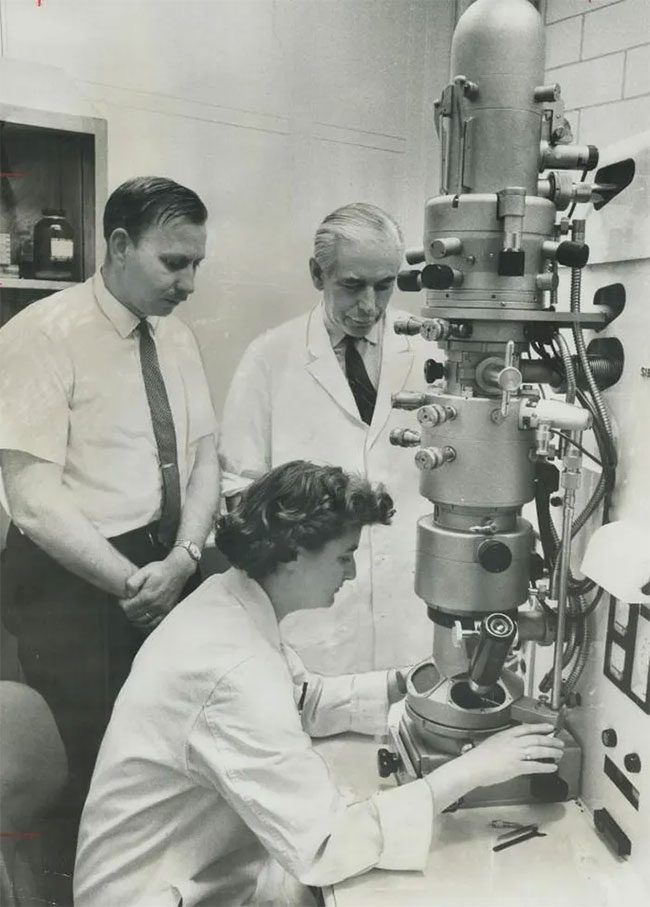June Almeida, born in 1930, was the woman who discovered the first human coronavirus in the world.
June Almeida was a Scottish virologist whose groundbreaking work in the 1960s led to the identification of the first human coronavirus. Almeida’s discovery represented a turning point in virology, paving the way for deeper research into coronaviruses and their potential impacts on human health.
She spent her childhood in a neighborhood near Alexandra Park, located in the northeast of Glasgow, England. At the age of 16, Almeida dropped out of school and began working as a research assistant in pathology at the Royal Infirmary of Glasgow. A few years later, she moved to London, married a Venezuelan artist named Enriques Almeida at the age of 24, and the family subsequently relocated to Toronto, Canada, where Almeida made significant strides in her career.

June Almeida.
According to writer George Winter: “During her time at the Ontario Cancer Institute, Almeida demonstrated her outstanding skills with electron microscopy. Additionally, she was a pioneer in using antibodies to synthesize viruses, making it easier for researchers to visualize them.”
Shortly thereafter, Almeida’s talent shone brightly, earning her numerous invitations to work at hospitals in the UK. In 1964, she moved to St. Thomas’s Hospital Medical School, which recently treated Prime Minister Boris Johnson for Covid-19. Here, Almeida began collaborating with Dr. David Tyrrell, who was researching at the common cold unit in Salisbury, Wiltshire, England.
At that time, Dr. Tyrrell and his research team had identified several types of viruses associated with the common cold from a group of volunteers. Among them was a particular strain known as strain B814, discovered from the nasal swab of a student at a boarding school in Surrey. The research team found that this new virus could spread among volunteers with typical cold symptoms, but they were unable to culture it. Moreover, they noted the virus’s growth in body tissues.

Coronavirus.
They quickly sent samples to June Almeida, who reported seeing viral particles under the microscope that resembled influenza viruses, yet were not exactly the same. Almeida confirmed this was the first recorded instance of the coronavirus found in humans. Writer Winter noted that Dr. Almeida had previously observed this virus while researching mouse hepatitis and infectious bronchitis in chickens. However, her research papers submitted to journals were rejected, with comments suggesting that the images she provided were merely poor-quality photos of influenza viruses.
By 1965, new findings regarding strain B814 were published in the British Medical Journal, and two years later, Almeida’s photographs were published in the journal General Virology. Dr. Tyrrell, Almeida, and the head of St. Thomas’s Hospital, Professor Tony Waterson, collectively named this new virus strain coronavirus because, under the electron microscope, it appeared to have a halo surrounding its exterior resembling a crown.
Almeida later switched jobs and earned her Ph.D. at the postgraduate medical school in London. She concluded her career at the Wellcome Institute, where she continued to receive multiple patents in the field of viral imaging. After leaving Wellcome, Almeida abandoned her scientific career to become a yoga instructor. By the late 1980s, she returned to the field as a consultant supporting HIV virus imaging. June Almeida passed away in 2007 at the age of 77.
“I have nothing but passion and determination”
Despite her many achievements, Almeida faced challenges and discrimination throughout her career solely because she was a woman in science. She had to overcome criticism of her perceived lowly background due to her lack of formal qualifications, as well as the gender discrimination she encountered.

Almeida dedicated her life to virology despite the challenges and discrimination she faced.
In an interview with the medical weekly The Lancet, Almeida stated: “I had no qualifications, no money, and no influential friends. All I had was passion and determination.”
“Without a doubt, Almeida was one of the finest scientists in Scotland at that time. But sadly, she was almost forgotten for a long time,” said Professor Hugh Pennington at the University of Aberdeen, Scotland, to National Geographic.
“It wasn’t until the Covid-19 pandemic broke out that people began to remember her significant research and contributions to science.”
Almeida’s work paved the way for further research into coronaviruses, including those responsible for the SARS, MERS, and Covid-19 outbreaks. Her legacy continues to profoundly influence many virologists and scientists who are advancing research on new viruses and developing treatments and vaccines to combat them.


















































